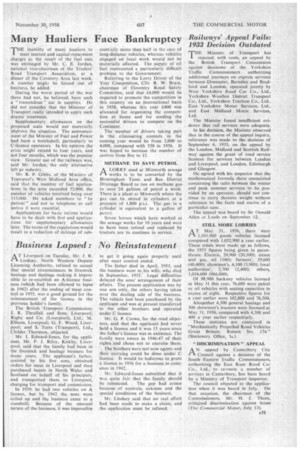Many Hauliers Face Bankruptcy
Page 33

If you've noticed an error in this article please click here to report it so we can fix it.
THE inability of many hauliers to meet interest and capital-repayment charges as the result of the fuel cuts was envisaged by Mr. C. E. Jordan, national vice-chairman of the Traders' Road Transport Association, at a
, dinner of the Coventry Area last week. A number might be forced out of business, he added.
During the worst period of the, war there had not, he believed, been such a " tremendous " cut in supplies. He did not consider that the Minister of Transport really intended to apply such drastic treatment.
Supplementary allowances on the proposed scale would not materially iniprove the situation. The announcement of the Minister of Ftiel and Power had been a bombshell, particularly to C-litence operators. In his opinion the crisis might extend to four years, and not four months, which was the popular view. Greater use of the railways was, said Mr. Jordan,the only alternative left So industry.
Mr. R. P. Gibbs. of the Ministry of Transport's West Midland Area office, said that the number of fuel applications in the area exceeded 52,000, the number of vehicles involved being over 115,000. He asked members to " be patient" and not to telephone or call unless it were essential Applications for basic rations would have to be dealt with first and applications for supplementary allowances later. The terms of the regulations would result in a reduction of mileage of sub stantially more than half in the case of long-distance vehicles, whereas vehicles engaged on local work would not be materially affected. The supply of oil fuel represented a particularly difficult problem to the Government.
Referring to the Lorry Driver of the Year Competition, Cllr. R. W. Brain, chairman or Coventry Road Safety Committee, said that £4,000 would be required to promote the competition in this country on an international basis in 1958, whereas this year 1400 was allocated for organizing the competition at home and for sending the successful drivers to compete on the Continent: The number of drivers taking part in the eliminating contests in the corning year would be from 2,000 to 4,000, compared with 550 in 1956. It was hoped to increase the number of centres from five to 1/.
METHANE TO SAVE PETROL
A LORRY used at Minworth sewage works is to be converted by the Birmingham Tame and Rea District Drainage Board to run on methane gas to save 24 gallons of petrol a week. There is a plant at Minworth where the gas can be stored in cylinders at a pressure of 1,800 p.s.i. The gas in a cylinder is equivalent to a gallon of petrol.
Seven horses which have worked at the sewage works for 10 years and were to have been retired and replaced by tractors are to continue in service.




























































































